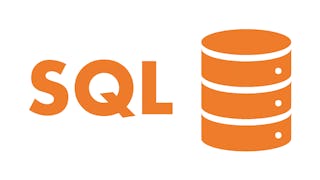Much of the world's data lives in databases. SQL (or Structured Query Language) is a powerful programming language that is used for communicating with and manipulating data in databases. A working knowledge of databases and SQL is a must for anyone who wants to start a career in Data Engineering, Data Warehousing, Data Analytics, Data Science or Business Intelligence. The purpose of this course is to help you learn and apply foundational and intermediate knowledge of the SQL language, and become familiar with many relational database (RDBMS) concepts along the way.

Enjoy unlimited growth with a year of Coursera Plus for $199 (regularly $399). Save now.

SQL: A Practical Introduction for Querying Databases
This course is part of multiple programs.

Instructor: Rav Ahuja
70,155 already enrolled
Included with
(676 reviews)
Recommended experience
What you'll learn
Analyze data within a database using SQL.
Create a relational database on Cloud and work with tables.
Write SQL statements including SELECT, INSERT, UPDATE, and DELETE.
Build more powerful queries with advanced SQL techniques like views, transactions, stored procedures and joins.
Skills you'll gain
Details to know

Add to your LinkedIn profile
See how employees at top companies are mastering in-demand skills

Build your subject-matter expertise
- Learn new concepts from industry experts
- Gain a foundational understanding of a subject or tool
- Develop job-relevant skills with hands-on projects
- Earn a shareable career certificate from IBM

There are 5 modules in this course
In this module, you will be introduced to databases. You will create a database instance on the cloud. You will learn some of the basic SQL statements. You will also write and practice basic SQL hands-on on a live database.
What's included
6 videos2 readings2 assignments3 app items1 plugin
In this module, you will explore the fundamental concepts behind databases, tables, and the relationships between them. You will then create an instance of a database, discover SQL statements that allow you to create and manipulate tables, and then practice them on your own live database.
What's included
5 videos2 readings2 assignments3 app items5 plugins
In this module, you will learn how to use string patterns and ranges to search data and how to sort and group data in result sets. You will also practice composing nested queries and execute select statements to access data from multiple tables.
What's included
7 videos2 readings4 assignments4 app items4 plugins
In this assignment, you will be working with multiple real world datasets for the city of Chicago. You will be asked questions that will help you understand the data just as you would in the real wold. You will be assessed on the correctness of your SQL queries and results.
What's included
2 videos2 assignments2 app items4 plugins
This module covers some advanced SQL techniques that will be useful for Data Engineers. If you are following the Data Engineering track, you must complete this module. In this module, you will learn how to build more powerful queries with advanced SQL techniques like views, transactions, stored procedures and joins.
What's included
6 videos5 readings5 assignments6 app items6 plugins
Earn a career certificate
Add this credential to your LinkedIn profile, resume, or CV. Share it on social media and in your performance review.
Explore more from Data Analysis
 Status: Preview
Status: PreviewUniversitat Politècnica de València
 Status: Free Trial
Status: Free Trial Status: Free Trial
Status: Free Trial Status: Free Trial
Status: Free Trial
Why people choose Coursera for their career




Learner reviews
676 reviews
- 5 stars
76.92%
- 4 stars
17.01%
- 3 stars
2.95%
- 2 stars
1.03%
- 1 star
2.07%
Showing 3 of 676
Reviewed on May 24, 2025
i have completed the whole course but then also i am noy getting any certificate downloading option
Reviewed on Feb 13, 2025
THE COURSE WAS GREAT I LEARNED ALOT BUT IT CAN BE IMPROVED THROUGH GOING DEEPER TO EACH AND EVERY BASIC CONCEPT
Reviewed on Nov 13, 2025
Overall it's a very good course; I really like how hands-on it is built. There were a few confusing parts with small mistakes in some labs but otherwise it's a great course.
Frequently asked questions
To access the course materials, assignments and to earn a Certificate, you will need to purchase the Certificate experience when you enroll in a course. You can try a Free Trial instead, or apply for Financial Aid. The course may offer 'Full Course, No Certificate' instead. This option lets you see all course materials, submit required assessments, and get a final grade. This also means that you will not be able to purchase a Certificate experience.
When you enroll in the course, you get access to all of the courses in the Certificate, and you earn a certificate when you complete the work. Your electronic Certificate will be added to your Accomplishments page - from there, you can print your Certificate or add it to your LinkedIn profile.
More questions
Financial aid available,
¹ Some assignments in this course are AI-graded. For these assignments, your data will be used in accordance with Coursera's Privacy Notice.





